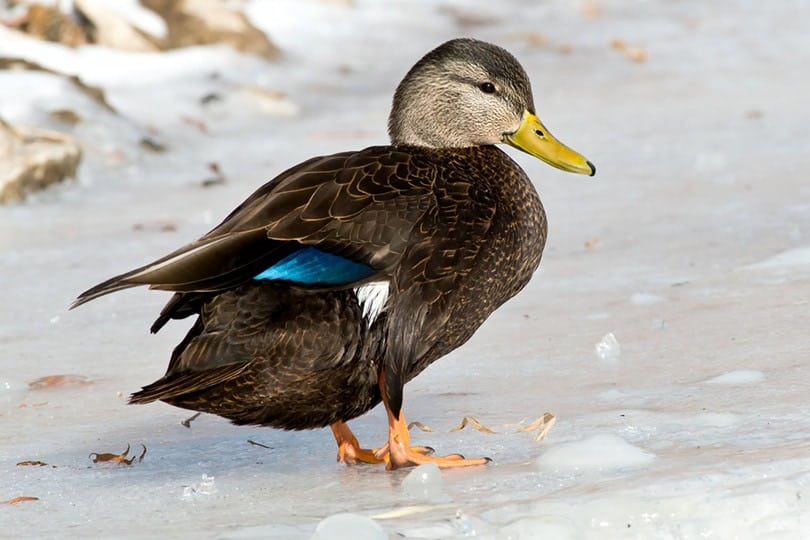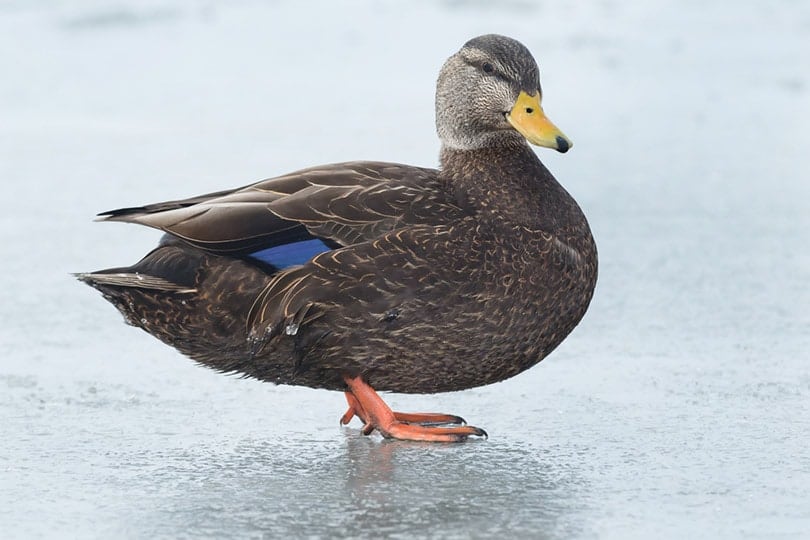The American Black Duck is one of the most breathtaking waterfowl species. They look a lot like Mallards but with darker foliage. This breed is prevalent in the northeastern areas of North America. They are primarily wild but can be used for small-scale farming.
This species does a great job of providing for itself and eating up all the insects on your property. Keep reading to learn more about the American Black Duck, including its traits and level of difficulty raising one.

Quick Facts About American Black Ducks
| Breed Name: | Anas rubripes |
| Place of Origin: | Eastern North America |
| Uses: | Eggs |
| Drake (Male) Size: | 1.6–3.6 pounds |
| Hen (Female) Size: | 1.5–3 pounds |
| Color: | Dark brown |
| Lifespan: | 26 years |
| Climate Tolerance: | Wetland |
| Care Level: | Beginner |
| Production: | Eggs |
American Black Duck Origins

The history or origins of the American Black Duck are relatively unknown. The American Black Duck was first described in 1902 by the American ornithologist William Brewster. However, we have found fossils of these ducks over 11,000 years old.
Since then, this duck has been one of the more popular duck breeds in eastern North America. Consequently, it is of the least concern in terms of the conservation status. However, the species is losing some of its habitats due to climate change and human invasion.
Historically, American Black Ducks have been wild migratory birds, which is still true today. Thankfully, there are more farmers welcoming these ducks on their wetland properties to help conserve the species.
American Black Duck Characteristics
American Black Ducks are considered a migratory species. They span as far south as Florida and as far north as northern Canada, but they are primarily found in eastern North America.
These ducks are most comparable to Mallards in size, appearance, and personality. They are so similar, in fact, that they often crossbreed on their own.
Uses
American Black Ducks are primarily a wild species, but they can be found on farms. They produce about 7 to 11 eggs that range from creamy-white to greenish in color.
These ducks also make great pest control. They prefer to eat plant matter and insects during the breeding season, including mayflies, dragonflies, flies, and beetles.
Appearance & Varieties
The American Black Duck is a large dabbling duck. They look a lot like a female Mallard, but they have a much darker coloration. Both males and females look similar. The main difference is that males have a yellow bill and females have a light green one.
American Black Ducks are breathtaking in flight. Their underwings have a white lining that contrasts the rest of the duck’s body. They also have purple spots on the front and back.
In terms of size, American Black Ducks are very large. In fact, they are the largest duck species within their family. It has the highest mean body mass of its genus. These ducks typically weigh between 1.5 and 3.6 pounds and are 21 to 23 inches long.
Population/Distribution/Habitat
American Black Ducks tend to stay around marshes, bays, and other wetlands. They prefer aquatic habitats, such as those found in northern forests. They can withstand a lot of climates and temperatures.
Currently, there is no problem with the population of the American Black Duck. Even so, their habitats are decreasing due to climate change and other environmental factors. This has caused the American and Canadian governments to provide certain incentives for these ducks. Some farm owners that live in wetlands are encouraged to open up their property for American Black Ducks to ensure the species continues thriving.
Are American Black Duck Good for Small-Scale Farming?
American Black Ducks are not necessarily the most popular farming duck simply because they are mainly found in the wild and are a migratory species. Even so, black ducks can be good for small-scale farming because they are hardy and take care of themselves.
These ducks will be able to provide you with some eggs and pest control. If you have wetlands on your farm, American Black Ducks can help keep flies and other insects at a minimum to protect your other animals. At the end of the day, most of these ducks live in the wild, but there is no reason why they can’t live on your property as well.
Featured Image Credit: Paul Reeves Photography, Shutterstock
